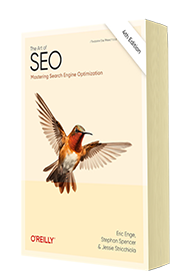10 Tips to Help Your Blog Soar in the Search Engines (Part 1 of 2)
Blogging is one of the hottest trends on the Web. Whether yours is an individual blog, a group blog, a character blog, or a CEO blog, there’s no doubt that, done right, a blog can position you as a thought leader, bring your Web presence to life, and help you engage with your customers.
But with over 75,000 new blogs created every single day, and tens of millions of blogs already in the blogosphere, it’s not a given that you’ll get found by your target audience and develop a loyal following of readers (case in point: the MarketingProfs “Daily Fix” blog and its quest for greater visibility.)
What can you do to pull in the crowds and to rise in the rankings? Read on and I’ll share my secrets.
Search Engines Love Blogs
You may recall from my article in November, “The Secrets of Building Links and Increasing PageRank,” that the major search engines all rely heavily on links to decide which Web sites are worthy of a top ranking. Blogs are looked on quite favorably in that regard, because the blogosphere is so rich with interlinkages. Bloggers link to each other constantly,from blogrolls, to trackbacks, to “hat tips.” Accordingly, blogs seem to get special treatment, particularly from Google.
Starting with just a few good links, a new blog can quickly penetrate Google’s top results where a brand new, traditional Web site might languish in the “Google sandbox” for a number of months with very poor visibility. Case in point: my 14-year-old daughter recently started a blog, Ultimate Neopets Cheats (about the hugely popular kids site Neopets.com), and within two weeks achieved a page-one ranking in Google for her targeted search terms of “Neopet cheats” and “Neopets cheats.”
Blogs also get indexed by blog-specific (and RSS feed-specific) search engine,like Technorati, Feedster, PubSub, Google Blog Search, and Yahoo News & Blog Search. But to blog owners, these specialized search sites are small potatoes in terms of traffic generation, because their reach and search volume is a small fraction of what is achieved by the major engines.
So the focus of this article will be on obtaining traffic and visibility from the major engines: Google, Yahoo, and MSN Search. After all, with most people turning to Google and Yahoo,does it really matter that you are number one in Technorati or Google Blog Search for a particular keyword?
So, without any further ado, I offer you 10 key tips that will help your blog soar in the major search engines. This week, I offer the first five; next week, the balance.
Tip #1: Your Title Tags
From a search engine optimization perspective, the title tag is the most important thing on the page. It gets the most weight by the search engines. Most blogs don’t have search engine optimal title tags. (Heck, most sites in general don’t have optimal title tags!)
The best title tag is one that LEADS with the targeted keywords. But, unfortunately, most blogs lead with the name of the blog. Instead, that should go at the end.
We recently did some optimization to BusinessBlogConsulting.com and I’m happy to say that’s now the case there: the blog name is at the end.
In addition, it’s good to customize the title tag of your home page to have some good keywords in them. For BusinessBlogConsulting.com, that meant including phrases like “corporate blogs” and “business blogging,” and including both singular and plural forms “blog” and “blogs,” as well as the verb tense “blogging.” (The old title tag was “Business Blog Consulting.” Now it’s “Business Blog Consulting: Everything about Corporate Blogs and Business Blogging.”)
Creating a custom title tag for your blog’s home page is well worth doing. Consider this: On my blog, Stephan Spencer’s Scatterings, I decided to target the search phrase “web marketing blog.” By simply changing the home page title tag from “Stephan Spencer’s Scatterings” to “Stephan Spencer’s Scatterings: Web Marketing Blog” and adding a mention of “Web marketing blog” once in the body copy, I went from nowhere for “Web marketing blog” in Google to currently #9 out of 166,000,000!
Of course, make sure that the keywords you are targeting aren’t just in the title tag but also in the body copy as well. Otherwise, it’s not reinforcing your keyword focus to the search engines sufficiently. On BusinessBlogConsulting.com we simply added “corporate blogs” to the home page title and once to the body copy, and within short order it went from nowhere in Google to page 2 (currently ranked at No. 11) for “corporate blogs.” Not bad for a couple of minutes of effort! (Read on to Tip No. 3 to see exactly how we did this within WordPress.)
Tip #2: Your URLs
Dynamic URLs can impede the search engine spiders from fully spidering and indexing your blog. Err on the side of caution and use “rewritten” URLs.
The excellent (and free!) blogging software WordPress supports URL rewriting, so you can have nice, search engine friendly URLs. Better still, the WordPress URLs contain hyphens rather than underscores (which TypePad and Movable Type employ), since underscores are not considered to be word separators by Google.
If you ever switch blog platforms, it’s imperative that the old permalink URLs still work. That’s because there will be numerous deep links into specific post pages in your blog from other bloggers, and that provides your blog with that all-important “link gain” (e.g. Google’s PageRank). You wouldn’t want to lose that!
Recently I assisted BusinessBlogConsulting.com with the conversion from TypePad to WordPress 2.0. As part of the migration, I ensured that the new WordPress permalink URLs would be consistent with the old TypePad permalink URLs. That means that the old posts still have underscores in them.
However, for new posts, the permalink URLs contain full words and hyphens, not underscores.
If for some reason you have to change the URLs, then at least redirect the old URLs to the new ones, and make sure that you do it as a permanent (301 style) redirect. That way, the link gain passes on to the new URL.
Also, make sure you 301 redirect requests for pages from your domain without the www (e.g., https://businessblogconsulting.com/category/adverblogs/) to the corresponding page on your www URL (e.g., https://www.businessblogconsulting.com/category/adverblogs/). This will eliminate duplicate pages in the search engine indices and consolidate link gain.
Otherwise, when people link to https://businessblogconsulting.com without the www, it creates another site for the search engines to visit and explore. The Permalink Redirect WordPress plugin is the easiest way to accomplish this for blogs running the WordPress software.
Tip #3: Tagging
I can’t believe how few bloggers take advantage of tags. I’m not talking about Technorati tags,although those are useful for SEO, too, since Technorati tag pages often rank in the first page of Google. I’m talking about using a tagging plugin (like Ultimate Tag Warrior for WordPress) that creates internal navigation based on tags (i.e., a “tag cloud”) and blog archive pages organized not by date or by category but by tag. A tag cloud and tag pages are a blogger’s secret weapon.
Once such a plugin is installed, if I want to target a new search term in the search engines, I simply add some relevant keywords to the Tag field in my post. Then, presto! I’ve got text links in my blog’s tag cloud that point to a new, automatically created tag page.
And, of course, make sure the tag name is mentioned at the beginning of the title tag and in the body copy! For those blogs on WordPress, here’s an example of the sort of code you’d put into your theme’s header to accomplish that:
<title><?php if (is_home()) { print "Business Blog Consulting: Everything about Corporate Blogs and Business Blogging."; }elseif (is_tag()) { UTW_ShowCurrentTagSet("", "%tagdisplay%"); print " : "; bloginfo('name'); } else { wp_title(' '); print " : "; bloginfo('name'); } ?></title>
You can further optimize the tag pages by adding some keyword-rich intro copy to each tag page, but that involves the use of “sticky” posts, which I’ll get to in Part 2 of this article series.
Tip #4: Related Posts
Having a Related Posts feature on your blog creates more interconnections between blog posts, which is a good thing as it passes around more link gain. I installed the Related Entries plugin on my blog so readers are able to see that each permalink page lists related posts at the bottom of the page.
Most blogs are over-reliant on the chronological archives, which tells the search engines to weight your recent posts more heavily. But an old post may be really well optimized and targeting a really important keyword. So that post needs more link gain, and that means more links pointing to that page and links from pages higher up in the site hierarchy.
Linking to related posts creates an alternative linking structure to augment your chronological archives.
Tip #5: Popular Posts
Wouldn’t it make sense to take your very best posts, regardless of posting date, and endow them with a maximum amount of link gain so that they have the most opportunity to rank well in the search engines? Putting together a Top 10 Posts list for your homepage will do exactly that, by strategically passing link gain from your blog’s homepage directly to these posts.
The great thing about a Top 10 list is that you can be as arbitrary as you want in determining which posts get onto this list. It could be the ones that lead with your most important keywords. Or the ones that most effectively soft sell your products or services. Or simply the posts you personally like the most. Just be careful to choose “evergreen” posts that won’t lose their appeal or value after a few days or weeks.
If you’re happy to leave it up to your readers to decide, then simply install a “most popular posts” plugin such as the Popularity Contest plugin for WordPress. The plugin automatically compiles the list based on which posts get viewed the most. You can publish the list on the home page and wherever else you see fit.
Continue to Part 2, the second and final installment, when we look at anchor text, “sticky” posts, heading tags, emphasis tags, and author pages…

Chapter 6:
Keyword Research
From the fundamentals of link building to the nuances of natural linking patterns, virality, and authority.
Related Posts

Embrace Journaling, Tackle Tardiness, and Explore Our Energetic Echo
Here’s what I found inspirational, challenging, or just downright hilarious this week. What caught your eye? And, remember to check out this week’s great podcast episodes: Scaling a SaaS Company with Jason Morehouse “A crucial factor to business success is to find and take the personal path that works best for you.” — Jason Morehouse […]
Read More
Harrison’s harmony, conquering a blank canvas, & gut health hacks
Here’s what I found inspirational, challenging, or just downright hilarious this week. What caught your eye? And, remember to check out this week’s great podcast episodes: Be a Sales Game Changer with Fred Diamond “True elite sales professionals develop a dedicated mindset, proactive client interaction, and continuous self-preparation. They understand their client’s needs and enable […]
Read More
Rebirth of sleeper trains, 4,000 weeks is a long/short time, and golden age for medicine
Here’s what I found inspirational, challenging, or just downright hilarious this week. What caught your eye? And, remember to check out this week’s great podcast episodes: A Story Worth Retelling with Luke Storey “Aligned values are the cornerstone of successful partnerships, whether in business or life, as they shape our moral code, define our priorities, […]
Read More
